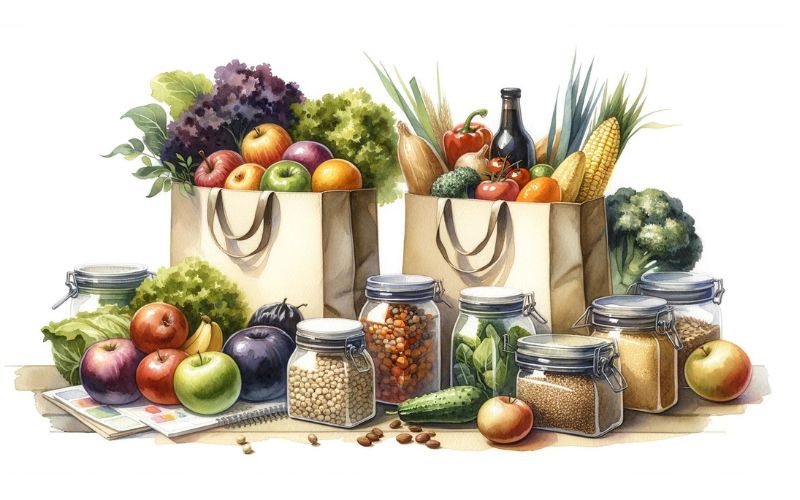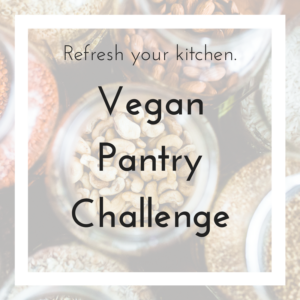Most people could cook faster, waste less money and time, and be less stressed if they handled their grocery haul differently. How should you store groceries to reduce waste and make cooking faster? Try these four strategies and share yours in the comments.
Clear your fridge before you shop
Don’t bring in fresh food without first reviewing your inventory.
- Make sure that you have a plan to eat or repurpose any leftovers you may have. If they have lost their appeal, it’s better to toss them now then in a couple of weeks!
- Check what produce you have and plan meals that will make the most of those vegetables and fruit. (Soup?)
- Discard anything that’s beyond salvaging or straight-up rotten.
- Are you running low on the core vegetables that form the base of most healthy vegan dishes? Add them to your list! (Review my list of 10 vegetables I never fail to put on my grocery list.)
- While you’re there, wipe the bottom of the drawers clean.
Pro tip: Line the bottom of your produce drawer with a cloth. Tea towels and facecloths work great. Replace it every week or two. It will catch excess moisture and make messes easier to clean.
Scan your pantry
Organizing yourself to save time and money starts before you hit the store. Don’t leave your home without checking what dry goods you already have.
- Are there core ingredients that you forgot to add to your shopping list, like pasta, brown rice, quinoa, beans, or anything else you use every week? Add those items to your shopping list. (Review my list of 75 pantry staples that form the base of all my healthy vegan meals.)
- Climb on a stool to inspect the back of your top shelves. Chances are there are some ingredients on your shopping list that are hiding back there, or simple substitutions that would make use of what you already have.
- Remove any spilled, spoiled, or otherwise unwanted items. If you have an open box of crackers that you haven’t finished in over a year, the odds are low that you’ll ever want to eat them. Compost the food, recycle the packaging, and learn more about how to prevent a pantry moth infestation.
- Why not wipe the shelves clean while you are there?
Aside from saving you money and increasing your control over your food inventory, doing a pre-shopping inventory will teach you lessons about your grocery shopping habits.
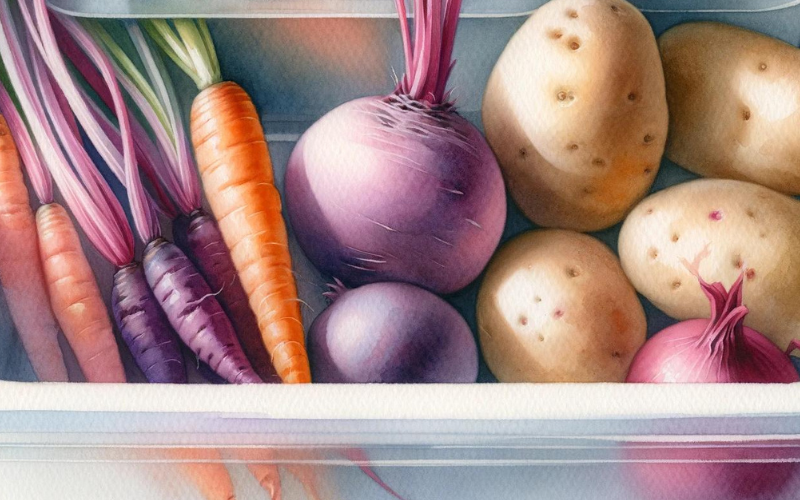
Store produce right
Fresh vegetables and fruit are the most precious foods in your kitchen and deserve to be handled with love and care. If you treat them right, and plan astutely, you can get away with shopping for produce only once per week.
Do not clean your vegetables before storing them! Contact with water will make them degrade faster. (Clean before cooking/eating with just water and a brush.)
Zero-waste tip: If you discover bruised produce items in your grocery haul, make a plan to eat them today. They will degrade faster than the rest.
Produce that goes in the fridge
- Store root vegetables (onions, potatoes, carrots, beets, etc.) separately from thin-skinned and leafy ones (bell peppers, eggplant, zucchini, all cruciferous veg, anything green). If you have two crisper drawers to keep them apart, that’s best. (See “other methods” below for more information about onions and potatoes.)
- Greens: Ready-to-eat greens in boxes or bags can be kept outside of the crisper drawer. Non-packaged greens must be kept in a drawer, container, or plastic bag to reduce air flow (which would cause them to wilt too fast).
- Mushrooms keep better in a paper bag. In or out of the crisper doesn’t matter much in my experience.
- Berries, cherries, and grapes should be kept in their plastic clamshell; those bought in bulk or in cardboard packaging should be transferred to a clear container with limited airflow, lined with a tea towel or paper towel – or reuse a clamshell.
- Fresh herbs: This is an unpopular opinion, but I don’t think they should be kept in water (like cut flowers). Just keep them in the crisper and EAT THEM as soon as possible. Whatever will not be eaten within 5 days should be blended or pureed, frozen in an ice cube tray, and transferred to an airtight zip-top bag or container kept in the freezer, to add to dishes later.
- Garlic and fresh ginger go in the “butter” compartment of my fridge. It’s just convenient.
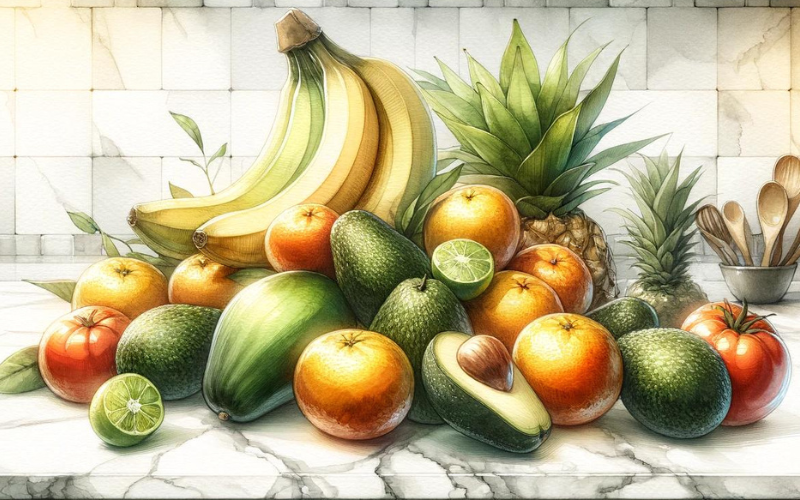
Produce stored on the countertop
- Winter squashes, like butternut and spaghetti squash, can generally stay on the countertop for several weeks.
- Bananas, oranges, lemon, and lime can stay on the countertop for a few days. Keep them visible so you remember to eat them regularly. In our family, we prefer apples cold and keep them refrigerated, but it’s ok to keep them on the countertop for a few days.
- Avocados start on the countertop. If I need them to ripen fast, I snuggle them up with bananas. Once they are just slightly soft, transfer to the crisper with the thin-skinned veggies. Same procedure goes for nectarines, peaches, and apricots.
- Tomatoes stay on the countertop and aren’t allowed to go more than a day beyond their “ripe” point. Their next storage spot is… in my mouth. Cherry tomatoes tend to keep for a while at room temperature.
Other grocery storage methods
- Some vegetables, like asparagus and corn, taste so much better when they are freshly harvested that I make a point of cooking them the same day they come home. Plan accordingly.
- Many sources recommend storing onions and potatoes in a cool dark place, just a little below room temperature if possible. That seems like a good idea, but I live in an apartment and that’s not an option for me. I also prefer keeping onions close at hand (because I use them every day) and refrigerated, because they are less likely to make me cry that way. I haven’t noticed any issues with conservation. The key is to never let them freeze.
- Produce-storage boxes make appealing photos for social media and Pinterest, but I don’t think they are necessary. Monitoring my produce inventory, lining the crisper drawers with tea towels to take care of the moisture, and not buying too much works for me.
- To take advantage of harvest-time low prices, I sometimes buy more onions or apples than can fit my fridge. I live in the Pacific Northwest so I am able to store them outdoors, on my covered deck, in cardboard boxes or thick brown paper bags. Nested right outside my patio door in a sheltered spot, they are sheltered from the elements. However, if the temperature is going to drop several degrees below freezing level, I take them indoors for the night.
Warning! If you are still buying meat, make sure to store it below (not above) your produce to prevent contamination.
Worry about the right thing. Countless studies have shown that people who eat more vegetables and fruit have healthier lives. Handle your food inventory with care, but don’t go overboard trying to store your produce perfectly. Your priority should be to actually cook and eat your greens, cruciferous, colorful. root, and other vegetables.
Transfer dry goods to jars
This grocery storage method takes a bit of effort to get started, but it’s life-changing when it comes to preparing meals quickly. The goal is to reduce the amount of time it takes to choose, identify, and pour out the necessary ingredients. Your whole plant food ingredient options should be stored neatly and visible at a glance, right where you need them while you are cooking – not in some distant pantry!
My own kitchen was a bit too messy to photograph at the moment so I asked my kind AI assistant to create something for me. There are way too many pull-out drawers here, but you get the picture:
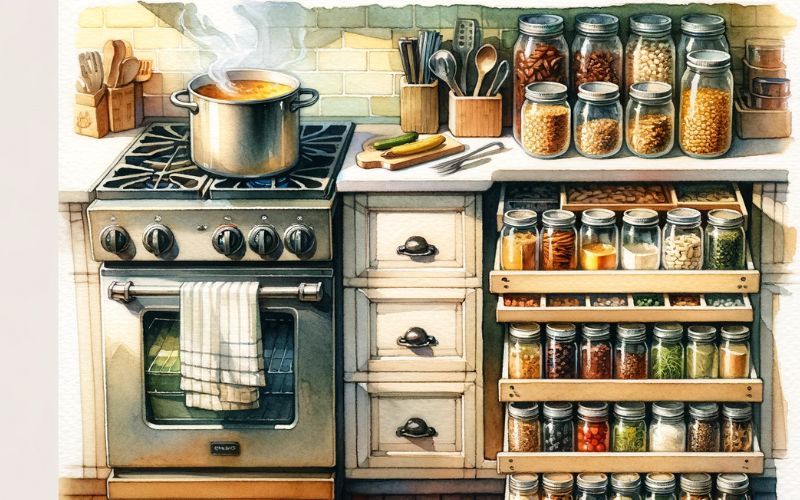
My AI assistant DALLE helped me create this image. This rendering features WAY more jars than would fit in a normal kitchen cabinet, but you get the idea: the food is accessible very close to the main food prep area.
The main benefits of this approach are that it:
- makes cooking faster: you open the drawer and see the ingredients you may need at a glance. It also reminds you of the foods you should be eating (whole grains, legumes, nuts and seeds…).
- constrains the number of ingredients you keep at any given time: if it doesn’t fit in an existing jar, you’re not buying it! (Practice substitutions.)
- and increases the shelf life of your ingredients by decreasing the air flow and the risk of a pest infestation.
Would you like to try? Here are the steps to get there:
- Assess how much space you have in the kitchen. Reorganize your storage so that frequently-used ingredients could be within arm’s reach of your main food preparation area. Utensils need to be close by, but pots and pans can be a few steps further away if it means making room for food storage.
- Identify the core dry ingredients you use on a regular basis. Those would include grains, beans, nuts, seeds, dried fruit, and assorted bits and bobs like nutritional yeast and baking soda. There should be somewhere between 15 and 40. (My own selection is based on the most-used items on my list of 75 vegan pantry staples.)
- Select your combination of storage containers. I love wide-mouth Mason jars of assorted sizes.
- If you have pull-out drawers, lucky you! Fill them up with the jars. If you don’t have pull-out drawers, you can gather the jars in shallow, sturdy plastic basket that fit inside your cabinets. Then you just need to pull out the basket to select the ingredients you need. If you can invest some time and money in improving your kitchen, you can purchase pull-out drawer kits from home hardware store.
- Identify a reserve, overflow area (away from your main food prep zone) where the food that doesn’t fit in the jars will be stored. When a given ingredient is starting to run low, check the overflow area to decide whether you should add the item to your grocery list or not.
Zero-waste tip: To find Mason jars, check your local thrift stores and ask on your Buy Nothing Group. I recommend buying new lids though.
You can do the same thing for spices, storing the overflow in a basket on a high shelf. Always check the content of the basket before buying a fresh refill from the grocery store.
Be aware of greenwashing
When researching how to store groceries, I was struck by the number of blog posts featuring “solutions” like supposedly zero-waste silicone bags and produce boxes for the fridge… along with affiliate links to Amazon. You don’t need to create consumer plastic (or glass or metal) waste to avoid food waste. Keep your grocery storage simple and keep eating those greens! And remember: the best way to avoid food waste is to actually eat the food you buy, so learn to buy your kale and eat it too.

